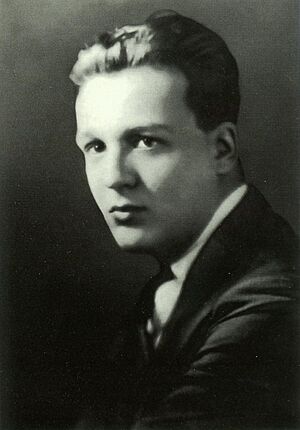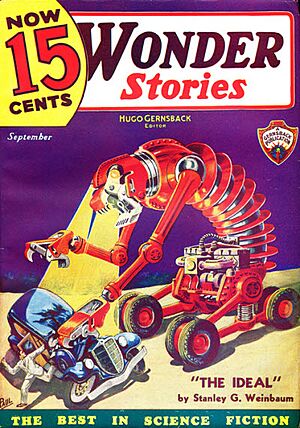Stanley G. Weinbaum facts for kids
Quick facts for kids
Stanley G. Weinbaum
|
|
|---|---|
 |
|
| Born | Stanley Grauman Weinbaum April 4, 1902 Louisville, Kentucky |
| Died | December 14, 1935 (aged 33) Milwaukee, Wisconsin |
| Pen name | Marge Stanley |
| Occupation | Writer |
| Nationality | American |
| Period | 1933–1935 |
| Genre | Science fiction, romantic fiction |
| Notable works | "A Martian Odyssey" |
Stanley Grauman Weinbaum (born April 4, 1902 – died December 14, 1935) was an American writer. He was famous for his science fiction stories. His very first science fiction story, "A Martian Odyssey", was published in July 1934. People loved it!
This story introduced an alien character named Tweel. Tweel was special because he thought differently from humans. He was smart, but not in a human way. This idea was very new for science fiction at the time. Weinbaum wrote more short stories and a few novels. Sadly, he died from lung cancer less than two years after his first story came out.
Contents
The Life of Stanley Weinbaum
Stanley Weinbaum was born in Louisville, Kentucky. His parents were Stella and Nathan Weinbaum.
He went to Riverside High School in Milwaukee. In 1920, he started college at the University of Wisconsin–Madison. He first studied chemical engineering. Later, he changed his major to English. However, he did not finish his degree. He left the university in 1923.
His Amazing Stories
Weinbaum is best known for his short story "A Martian Odyssey". This story was groundbreaking. It showed an alien, Tweel, who was not human-like but still easy to understand. This was his first science fiction story. Before that, in 1933, he wrote a romantic novel called The Lady Dances.
Famous science fiction writer Isaac Asimov said "A Martian Odyssey" was a perfect story. He thought Tweel might be the first alien in science fiction who thought as well as a human, but not like a human. Asimov also said it was one of only three stories that changed how all future science fiction stories were written. This story was chosen for The Science Fiction Hall of Fame, Volume One, 1929–1964. This book collects the best science fiction stories.
Most of Weinbaum's work came out in magazines like Astounding or Wonder Stories. Some of his stories also appeared in early science fiction fan magazines. He even wrote an "Auto-Biographical Sketch" in one of these magazines in 1935.
Unfinished Works and Adaptations
When he died, Weinbaum was writing a novel called Three Who Danced. This book was about a prince who danced with three local girls. Each girl's life changed because of this unexpected event.
In 1993, Weinbaum's wife, Margaret Hawtof Kay, gave his writings to the Temple University Library. These papers included Three Who Danced and other stories that had never been published. Most of these were romance stories.
One of Weinbaum's short stories, "The Adaptive Ultimate", was made into a movie in 1957. It was called She Devil. The story was also turned into a TV show episode. It appeared on Studio One in 1949.
Awards and Recognition
Stanley Weinbaum has a crater on Mars named after him! This is a great honor. In 2008, he also won the Cordwainer Smith Rediscovery Award. This award celebrates forgotten science fiction writers whose work is important.
Weinbaum's Universe: Planetary Series
Weinbaum wrote nine stories that all take place in the same solar system. He made sure the science in his stories was accurate for his time. For example, the bird-like plants on Mars in "A Martian Odyssey" are mentioned in other stories. The creatures from Venus in "Parasite Planet" also appear in other tales.
In Weinbaum's solar system, the giant planets like Jupiter and Saturn give off heat. This heat warms their moons, making them feel like Earth. So, moons like Io and Europa could have environments like ours. Mars in his stories was also Earth-like enough for humans to walk on it.
The Van Manderpootz Stories
Three of Weinbaum's short stories are about a character named Dixon Wells. Dixon is a playboy who is always late. He often gets into trouble because of the inventions of his friend, Professor Haskel van Manderpootz. The professor is a very smart but humble genius. He thinks Albert Einstein is almost as smart as him!
In "The Worlds of If", Dixon tries a machine that shows him what might have happened in his life. In "The Ideal", the professor creates a device that shows a person's perfect match. For Dixon, it shows his ideal woman. Another invention in "The Point of View" lets you see the world through someone else's eyes. In all these stories, Dixon finds his dream woman, but then loses her.


